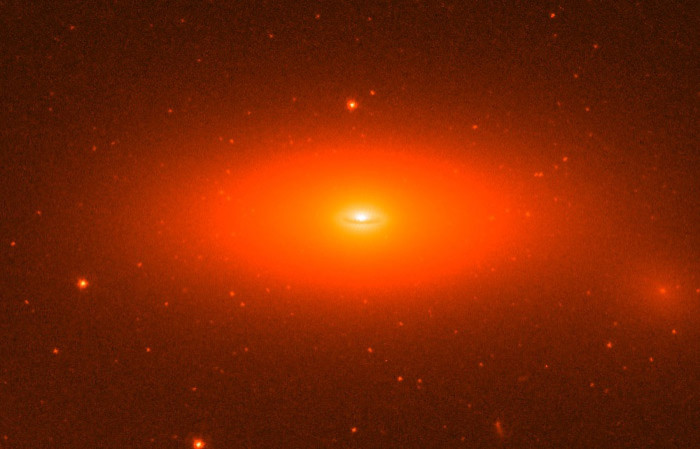Bigger, More Powerful Black Holes Discovered

Astronomers are finding new black holes that are bigger and more powerful than any seen ever before.
In an upcoming paper in the journal Nature, University of Texas at Austin researchers describe how they found a black hole 220 million light-years away from the constellation Perseus whose mass is 17 billion times the mass of our sun, making it a strong contender for the most massive black hole yet discovered.
Just to give you a sense of how massive the object is, consider that the Earth's sun has a mass of nearly 2 times 10 to the thirtieth power (so 2 followed by 30 zeroes) kilograms, or about 2 octillion tons. Then imagine 17 billion times 2 octillion.
The massive black hole lies at the heart of a galaxy called NGC 1277, and it has a monster diameter more than 11 times wider than the width of Neptune's orbit around the sun. It would take a beam of light around 4 days to cover a distance equal to the black hole's diameter.
What's surprising to researchers is that NGC 1277 is a relatively tiny galaxy in comparison to our Milky Way, at about a tenth of the size. The galaxy is also lens-shaped, which is unusual because massive black holes are typically found inside “elliptical” galaxies, which look like great big blobs of stars.
"This is a really oddball galaxy," study author Karl Gebhardt said in a statement on Wednesday. "It's almost all black hole. This could be the first object in a new class of galaxy-black hole systems."
Because a black hole sucks light and matter into it, scientists can't directly observe these objects with telescopes. Instead, they have to look at how a black hole affects the matter around it. Gebhardt and his team calculated the mass of the black hole at the center of NGC 1277 by using a telescope to observe the motion of stars around the object.
Another team of researchers announced a big black hole find on Wednesday. A group from Virginia Tech and the Isaac Newton Group in Spain said they'd found the most powerful quasar discovered yet. A quasar is a very bright galaxy powered by a central black hole that accelerates the material outside of its event horizon -- the “point of no return” beyond which it is impossible for matter to escape the grip of the black hole -- as it pulls matter into its center.
“The rate that energy is carried away by this huge mass of material ejected at high speed from [the quasar] is at least equivalent to two million million times the power output of the Sun. This is about 100 times higher than the total power output of the Milky Way galaxy -- it's a real monster of an outflow," Virginia Tech researcher Nahum Arav said in a statement Wednesday.
Hugely energetic quasars are predicted by theoretical simulations, but this is the first time such an object has been seen in reality. The team deduced the energy of the object, dubbed SDSS J1512+1119, by using equipment at the European Southern Observatory's facility in Chile to split light coming from the quasar into its component colors and using the spectrum to figure out how fast material was moving around the object.
A paper outlining the quasar team's findings is forthcoming in The Astrophysical Journal.
Black holes are mysterious by nature. Despite the name, they aren't giant empty areas of space, but lots of matter packed very tightly into a small space.
To grasp just how densely packed a black hole is, “think of a star ten times more massive than the Sun squeezed into a sphere approximately the diameter of New York City,” NASA advises.
A black hole is most often forged from the corpse of a star that has gone supernova, though some are the product of two stars colliding. There are also theoretical micro black holes, formed by the collisions of tiny particles, though researchers believe these quantum-sized objects would likely evaporate almost instantaneously.
In the realm behind the event horizon of a black hole, space and time get more and more jumbled up, and at the very center of the black hole lies the singularity, where the pull of gravity is infinitely strong and concepts like 'space' and 'time' no longer really apply.
Scientists think that pretty much all galaxies have a black hole at their center, and in October, NASA scientists got a pretty good look at the one at the heart of the Milky Way. Thankfully, our local black hole, which is called Sagittarius A*, or Sgr A*, is not very active compared to the black holes inside other galaxies, which are much more ravenous. Researchers still don't fully understand why Sgr A* has a relatively smaller appetite than other black holes.
NASA scientists were able to capture one outburst of X-rays that came from Sgr A* as it took in one of its rare meals.
The observations “will help us better understand the gentle giant at the heart of our galaxy and why it sometimes flares up for a few hours and then returns to slumber," CalTech researcher Fiona Harrison said in October.
© Copyright IBTimes 2024. All rights reserved.





















